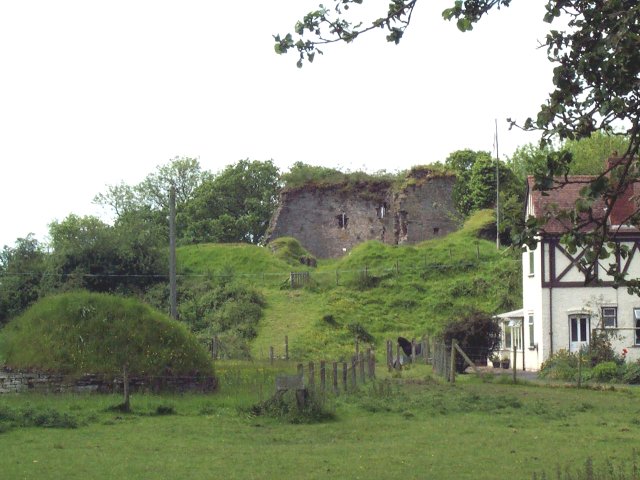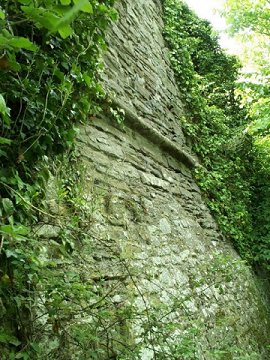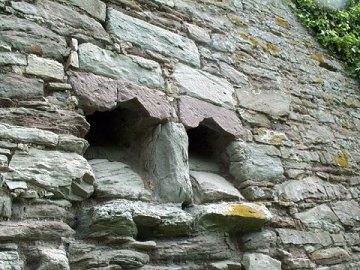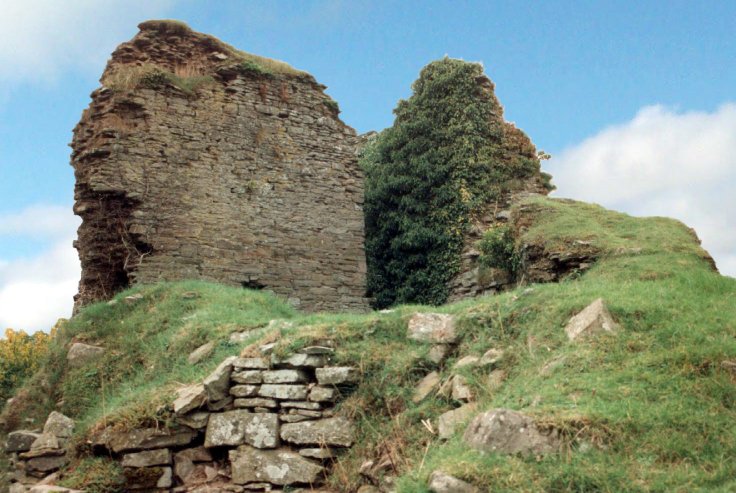Clifford
 Clifford castle stands on an eastward flowing section
of the River Wye near to the current boundary between England and Wales. The
castle was founded by Earl William Fitz Osbern in the period between his being
made earl of Hereford soon after Christmas 1066 and his death at the battle of
Cassel in Flanders on 22 February 1071. In that time it is likely that his
engineers found the natural knoll lying alongside the steep drop to the River
Wye near a ford. This gave the site its later name, the cliff by the ford or
Clifford. Fitz Osbern's men scarped and ditched the knoll they found into what
is today a motte with a secondary platform to the West. The land of Clifford was
at that time waste, but under the earls of Hereford and their successors this
waste was brought to blossom with castle, borough and church. After Earl
William's death, his son, Earl Roger, held the castle for four years until his
revolt in 1075. Then, on Roger’s imprisonment, the castle passed to his
father's brother-in-law, Ralph Tosny (d.1102), and he and his descendants held
the castle until the wars of Stephen and Matilda between 1138 and 1154.
Clifford castle stands on an eastward flowing section
of the River Wye near to the current boundary between England and Wales. The
castle was founded by Earl William Fitz Osbern in the period between his being
made earl of Hereford soon after Christmas 1066 and his death at the battle of
Cassel in Flanders on 22 February 1071. In that time it is likely that his
engineers found the natural knoll lying alongside the steep drop to the River
Wye near a ford. This gave the site its later name, the cliff by the ford or
Clifford. Fitz Osbern's men scarped and ditched the knoll they found into what
is today a motte with a secondary platform to the West. The land of Clifford was
at that time waste, but under the earls of Hereford and their successors this
waste was brought to blossom with castle, borough and church. After Earl
William's death, his son, Earl Roger, held the castle for four years until his
revolt in 1075. Then, on Roger’s imprisonment, the castle passed to his
father's brother-in-law, Ralph Tosny (d.1102), and he and his descendants held
the castle until the wars of Stephen and Matilda between 1138 and 1154.
 During
the years of Tosny lordship the castle was transformed into a great stone
structure of which there are some remains today. The caput of the family was the
castle of Conches in Normandy. Here the Tosny's built a great shell keep with
five round towers in the enceinte. A similar structure remains at Clifford and
the implication is that both structures are the work of the house of Tosny. With
the wars of Stephen and Matilda the Tosny's hold on Clifford castle weakened.
Roger Tosny's steward, Walter Fitz Richard, had for a long time been calling
himself Walter Clifford and had married Margaret Isobel Tosny, Roger's sister. In 1144 he
still acknowledged Roger as his overlord of Clifford, but by the end of the war
he had made himself de facto lord of Clifford and refused to return castle and
lordship to their rightful owners. During the reign of King Henry
II, Walter
Clifford cleverly introduced his daughter, renowned as the Fair Rosamund for her
beauty, to the king. Soon the two became lovers and Walter's powerful daughter
ensured that he never lost control of Clifford to its rightful owners.
During
the years of Tosny lordship the castle was transformed into a great stone
structure of which there are some remains today. The caput of the family was the
castle of Conches in Normandy. Here the Tosny's built a great shell keep with
five round towers in the enceinte. A similar structure remains at Clifford and
the implication is that both structures are the work of the house of Tosny. With
the wars of Stephen and Matilda the Tosny's hold on Clifford castle weakened.
Roger Tosny's steward, Walter Fitz Richard, had for a long time been calling
himself Walter Clifford and had married Margaret Isobel Tosny, Roger's sister. In 1144 he
still acknowledged Roger as his overlord of Clifford, but by the end of the war
he had made himself de facto lord of Clifford and refused to return castle and
lordship to their rightful owners. During the reign of King Henry
II, Walter
Clifford cleverly introduced his daughter, renowned as the Fair Rosamund for her
beauty, to the king. Soon the two became lovers and Walter's powerful daughter
ensured that he never lost control of Clifford to its rightful owners.
In 1233 Walter Clifford’s grandson, another Walter
Clifford, rebelled against King Henry III rather than return the castle to the
Tosnys. This led to the castle’s only known siege by Henry III. After just a
few days the castle surrendered to the king under the threat of death for the
garrison. Walter
himself had retreated into Wales and attempted to persuade his father-in-law,
Prince Llywelyn ab Iorwerth, to join him in rebellion. On failing to achieve this aim
Walter met the king at Shrewsbury and made his peace. Within a month Walter was
back in the Welsh Marches leading a royal army against Prince Llywelyn who had
finally thrown his power behind the rebels! Such were the convoluted twists and
turns of thirteenth century politics!
 Twenty years later the king served a writ
on the now ancient Walter Clifford, ordering him to observe the king’s command
in his Marcher barony. This was in breach of Walter’s Marcher privileges and
in a fit of pique he made the royal messenger eat the writ, seal and all. In
those days the king’s seal would have consisted of a dinner plate sized piece
of wax! Once more a king of England marched against a baron of Clifford, but
this time the septuagenarian lord of Clifford surrendered without a fight,
losing all his hard won gains of independence. Walter died, having regained the
king’s favour, in 1263.
Twenty years later the king served a writ
on the now ancient Walter Clifford, ordering him to observe the king’s command
in his Marcher barony. This was in breach of Walter’s Marcher privileges and
in a fit of pique he made the royal messenger eat the writ, seal and all. In
those days the king’s seal would have consisted of a dinner plate sized piece
of wax! Once more a king of England marched against a baron of Clifford, but
this time the septuagenarian lord of Clifford surrendered without a fight,
losing all his hard won gains of independence. Walter died, having regained the
king’s favour, in 1263.
In 1271 Walter’s widowed daughter and heiress
Matilda was kidnapped from her home by the young John Giffard of
Brimpsfield. In
terror she managed to get a letter to the king telling of her abduction and
rape. Once more Henry III took to the field, this time for the honour of the
baroness of Clifford. However, before he had proceeded far he received another
letter from Matilda saying everything was all right now and she had married her
abductor! The marriage was subsequently blessed by the birth of two daughters
before Matilda’s death in 1284. By 1311 the castle had passed into the hands
of the Mortimers and from that time forth was left to gently decay as just one
more castle in the hands of that powerful family.
 Clifford
castle now consists of a great motte as
constructed by the men of William Fitz Osbern back in the late 1060's.
This was
later sub-divided and the eastern part was crowned by an ovoid shell
keep with
five D shaped towers in its circuit. Two of these formed a small twin
towered gatehouse. The north wall of the keep appears to overlie
part of
William Fitz Osbern’s original hall. To the east of the motte is
the castle
bailey. Most of the walls of this structure have disappeared, but
centrally are
the remains of a great twin-towered gatehouse possibly of the mid
thirteenth century.
Clifford
castle now consists of a great motte as
constructed by the men of William Fitz Osbern back in the late 1060's.
This was
later sub-divided and the eastern part was crowned by an ovoid shell
keep with
five D shaped towers in its circuit. Two of these formed a small twin
towered gatehouse. The north wall of the keep appears to overlie
part of
William Fitz Osbern’s original hall. To the east of the motte is
the castle
bailey. Most of the walls of this structure have disappeared, but
centrally are
the remains of a great twin-towered gatehouse possibly of the mid
thirteenth century.
Various English examples of great gatehouses bearing similarities to the two at Clifford are at Beeston, Bungay, Dover, Longtown, Pembridge, St Briavels, the Tower of London and Whittington. In Wales they exist at Caerphilly, Carmarthen, Chepstow, Criccieth, Degannwy, Dinas Bran, Llanstephan, Llawhaden, Neath, Oystermouth, Powis, Rhuddlan, Tinboeth and White Castle. In Scotland they can be found at Kildrummy and Urquhart and finally elsewhere in Ireland at Carrickfergus, Castle Roche, Limerick and Roscommon.
To the west of the castle is a broken earthwork dam
which
would have flooded the valley to the south of the castle. With the
River Wye to
the north the fortress would have been surrounded by water on all sides
except
for the east. As such it would have been a very difficult fortress to
take by
storm. Half a mile to the south are the remains of the castle borough
with the
church of Clifford. Within lies a wooden monument which possibly
represents
Simon Clifford, the son of the first Walter Clifford and brother of
Fair
Rosamund.
Paul Remfry
Order Clifford Castle, 1066 to 1299 (ISBN 1899376534) for £9.95 through the PayPal
basket below.
Copyright©1994-2007
Paul Martin Remfry
 During
the years of Tosny lordship the castle was transformed into a great stone
structure of which there are some remains today. The caput of the family was the
castle of Conches in Normandy. Here the Tosny's built a great shell keep with
five round towers in the enceinte. A similar structure remains at Clifford and
the implication is that both structures are the work of the house of Tosny. With
the wars of Stephen and Matilda the Tosny's hold on Clifford castle weakened.
Roger Tosny's steward, Walter Fitz Richard, had for a long time been calling
himself Walter Clifford and had married Margaret Isobel Tosny, Roger's sister. In 1144 he
still acknowledged Roger as his overlord of Clifford, but by the end of the war
he had made himself de facto lord of Clifford and refused to return castle and
lordship to their rightful owners. During the reign of King Henry
II, Walter
Clifford cleverly introduced his daughter, renowned as the Fair Rosamund for her
beauty, to the king. Soon the two became lovers and Walter's powerful daughter
ensured that he never lost control of Clifford to its rightful owners.
During
the years of Tosny lordship the castle was transformed into a great stone
structure of which there are some remains today. The caput of the family was the
castle of Conches in Normandy. Here the Tosny's built a great shell keep with
five round towers in the enceinte. A similar structure remains at Clifford and
the implication is that both structures are the work of the house of Tosny. With
the wars of Stephen and Matilda the Tosny's hold on Clifford castle weakened.
Roger Tosny's steward, Walter Fitz Richard, had for a long time been calling
himself Walter Clifford and had married Margaret Isobel Tosny, Roger's sister. In 1144 he
still acknowledged Roger as his overlord of Clifford, but by the end of the war
he had made himself de facto lord of Clifford and refused to return castle and
lordship to their rightful owners. During the reign of King Henry
II, Walter
Clifford cleverly introduced his daughter, renowned as the Fair Rosamund for her
beauty, to the king. Soon the two became lovers and Walter's powerful daughter
ensured that he never lost control of Clifford to its rightful owners. Clifford castle stands on an eastward flowing section
of the River Wye near to the current boundary between England and Wales. The
castle was founded by Earl William Fitz Osbern in the period between his being
made earl of Hereford soon after Christmas 1066 and his death at the battle of
Cassel in Flanders on 22 February 1071. In that time it is likely that his
engineers found the natural knoll lying alongside the steep drop to the River
Wye near a ford. This gave the site its later name, the cliff by the ford or
Clifford. Fitz Osbern's men scarped and ditched the knoll they found into what
is today a motte with a secondary platform to the West. The land of Clifford was
at that time waste, but under the earls of Hereford and their successors this
waste was brought to blossom with castle, borough and church. After Earl
William's death, his son, Earl Roger, held the castle for four years until his
revolt in 1075. Then, on Roger’s imprisonment, the castle passed to his
father's brother-in-law, Ralph Tosny (d.1102), and he and his descendants held
the castle until the wars of Stephen and Matilda between 1138 and 1154.
Clifford castle stands on an eastward flowing section
of the River Wye near to the current boundary between England and Wales. The
castle was founded by Earl William Fitz Osbern in the period between his being
made earl of Hereford soon after Christmas 1066 and his death at the battle of
Cassel in Flanders on 22 February 1071. In that time it is likely that his
engineers found the natural knoll lying alongside the steep drop to the River
Wye near a ford. This gave the site its later name, the cliff by the ford or
Clifford. Fitz Osbern's men scarped and ditched the knoll they found into what
is today a motte with a secondary platform to the West. The land of Clifford was
at that time waste, but under the earls of Hereford and their successors this
waste was brought to blossom with castle, borough and church. After Earl
William's death, his son, Earl Roger, held the castle for four years until his
revolt in 1075. Then, on Roger’s imprisonment, the castle passed to his
father's brother-in-law, Ralph Tosny (d.1102), and he and his descendants held
the castle until the wars of Stephen and Matilda between 1138 and 1154.
 Twenty years later the king served a writ
on the now ancient Walter Clifford, ordering him to observe the king’s command
in his Marcher barony. This was in breach of Walter’s Marcher privileges and
in a fit of pique he made the royal messenger eat the writ, seal and all. In
those days the king’s seal would have consisted of a dinner plate sized piece
of wax! Once more a king of England marched against a baron of Clifford, but
this time the septuagenarian lord of Clifford surrendered without a fight,
losing all his hard won gains of independence. Walter died, having regained the
king’s favour, in 1263.
Twenty years later the king served a writ
on the now ancient Walter Clifford, ordering him to observe the king’s command
in his Marcher barony. This was in breach of Walter’s Marcher privileges and
in a fit of pique he made the royal messenger eat the writ, seal and all. In
those days the king’s seal would have consisted of a dinner plate sized piece
of wax! Once more a king of England marched against a baron of Clifford, but
this time the septuagenarian lord of Clifford surrendered without a fight,
losing all his hard won gains of independence. Walter died, having regained the
king’s favour, in 1263.  Clifford
castle now consists of a great motte as
constructed by the men of William Fitz Osbern back in the late 1060's.
This was
later sub-divided and the eastern part was crowned by an ovoid shell
keep with
five D shaped towers in its circuit. Two of these formed a small twin
towered gatehouse. The north wall of the keep appears to overlie
part of
William Fitz Osbern’s original hall. To the east of the motte is
the castle
bailey. Most of the walls of this structure have disappeared, but
centrally are
the remains of a great twin-towered gatehouse possibly of the mid
thirteenth century.
Clifford
castle now consists of a great motte as
constructed by the men of William Fitz Osbern back in the late 1060's.
This was
later sub-divided and the eastern part was crowned by an ovoid shell
keep with
five D shaped towers in its circuit. Two of these formed a small twin
towered gatehouse. The north wall of the keep appears to overlie
part of
William Fitz Osbern’s original hall. To the east of the motte is
the castle
bailey. Most of the walls of this structure have disappeared, but
centrally are
the remains of a great twin-towered gatehouse possibly of the mid
thirteenth century.